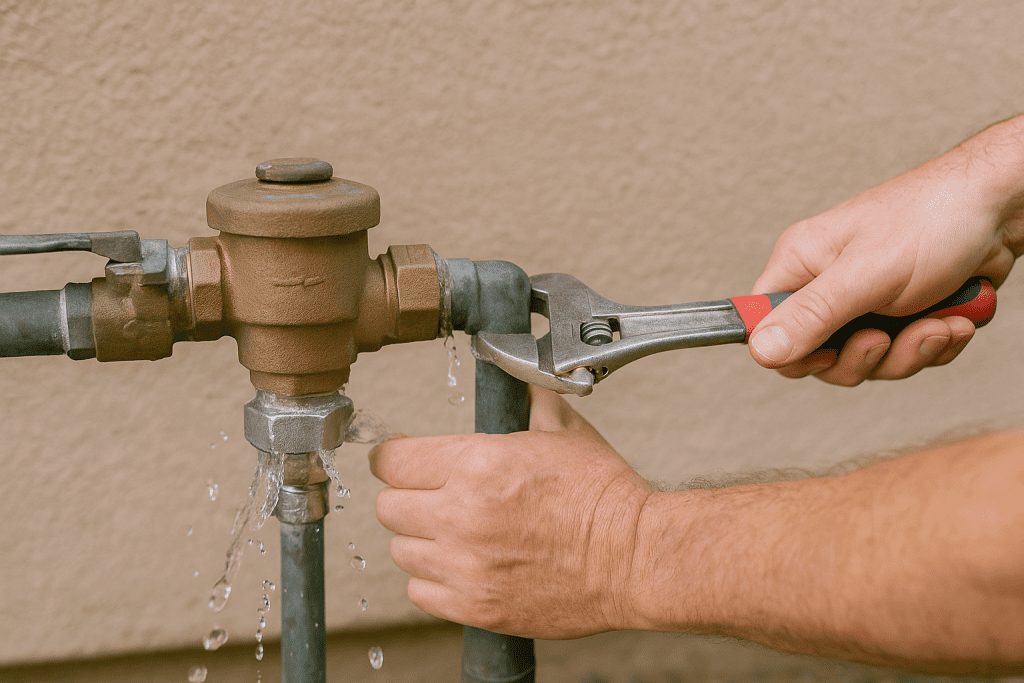
Alright, quick story.
A couple of weeks ago, I noticed water building up near my sprinkler valve box. At first, I figured maybe the dog spilled something (he’s clumsy). But nope—it was the backflow preventer leaking. Just a slow drip, but steady enough to grab my attention.
I thought, “This is going to cost me.” Turns out, not necessarily. If you’re dealing with the same thing, this post might help you sort it out without calling a plumber right away.
Wait, What’s a Backflow Preventer Again?
Basically, it’s that little valve that keeps dirty water (think pesticides, dirt, who-knows-what) from flowing back into your clean water lines. It’s mostly used with sprinkler systems, pools, or any setup where water could get contaminated and pushed the wrong way.
When it starts leaking, it doesn’t always mean disaster. But it does mean something’s off—maybe just a little issue or maybe a sign it’s time for maintenance.
Why It Might Be Leaking
From what I’ve seen (and read when I panicked and Googled), here’s what usually causes it:
- Rubber seals inside are worn out
- A freeze might’ve caused a crack
- Something got stuck in the valve
- The water pressure is too high or bounces around
- Or… it’s just old and tired
Mine was leaking from the relief valve in the middle—apparently that’s super common.
What I Did to Fix It (DIY-Style)
Again, I’m not a plumber. I’m just a guy who didn’t want to spend a few hundred bucks unless I absolutely had to. Here’s what worked for me.
Step 1: Shut Off the Water
Sounds simple, but easy to forget. Turn off the water going into the backflow preventer so you’re not working under pressure (literally).
Step 2: Look Closely
I dried it off and waited to see exactly where the water was coming from. If it’s from a connection or fitting, sometimes tightening does the trick. If it’s the actual valve body or the little relief hole, it’s probably internal.
Step 3: Clean It Out
I opened it up (followed a YouTube tutorial for my model), and sure enough—there was gunk inside. Bits of dirt, grass, even a pebble. Cleaned it with a cloth and toothbrush, flushed it gently, and put it back.
Leak slowed down… but still there.
Step 4: Repair Kit Time
I ordered a cheap repair kit online that had the exact seals and springs I needed. Swapped the old parts out—honestly easier than I expected. Just took my time and didn’t force anything.
Step 5: Slowly Turn Water Back On
Gently opened the shutoff. Watched for a few minutes. No leak. Waited an hour. Still dry. Checked again the next day. Boom—problem solved.
When a Repair Might Not Cut It
Let me be straight: if it’s cracked, corroded, or leaking in multiple places, don’t waste time on a patch-up. It’s better to replace it. Some signs it’s past its prime:
- You’ve repaired it already, and it’s leaking again
- You see visible cracks (especially if it froze)
- It’s over 10–15 years old
- Local codes require a new model anyway
A replacement sounds like a pain, but it saves you from a surprise inspection fine or worse—contaminated water.
Common Questions I Had (And You Probably Do Too)
Why is water coming out of the relief valve?
Usually pressure-related or something’s stuck inside. Could also mean the spring or rubber seat is damaged.
Is it safe to ignore a small leak?
Honestly? No. Even a small one can cause bigger problems, especially if it runs for days or seeps into your foundation.
Can I use sealant or plumber’s tape?
Only on pipe threads—not on the valve housing or relief parts. I made that mistake once—don’t do it.
Should You Call a Pro?
If you’re unsure, don’t want to mess with plumbing, or your city requires certified backflow testing (some do), go ahead and call a plumber. Nothing wrong with playing it safe.
But if you’re handy and don’t mind getting your hands a little dirty, the DIY route can actually be kind of satisfying. Plus, you save a couple hundred bucks.
One Last Thing
Look—if your backflow preventer is leaking, don’t wait weeks and hope it fixes itself. It won’t. But that doesn’t mean you need to panic either. A little cleaning, a quick part swap, or a full replacement—it’s manageable.
Just take it one step at a time. That’s what I did, and it worked.
Author
-

James is a certified backflow specialist with over 20 years of hands-on experience in plumbing safety.
He’s passionate about educating homeowners and businesses on the importance of clean water systems.
James simplifies complex maintenance tips through clear, practical advice.
When he's not writing, you'll find him inspecting valves or training the next generation of backflow testers.

